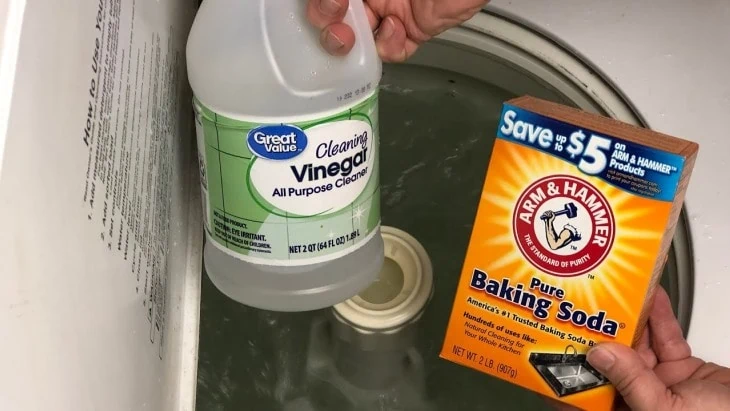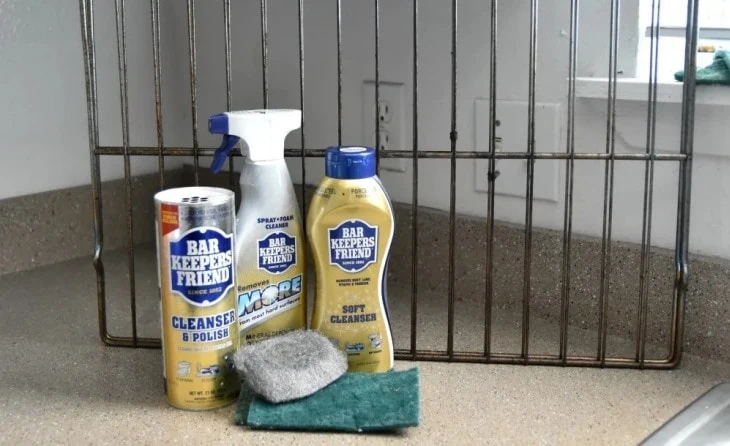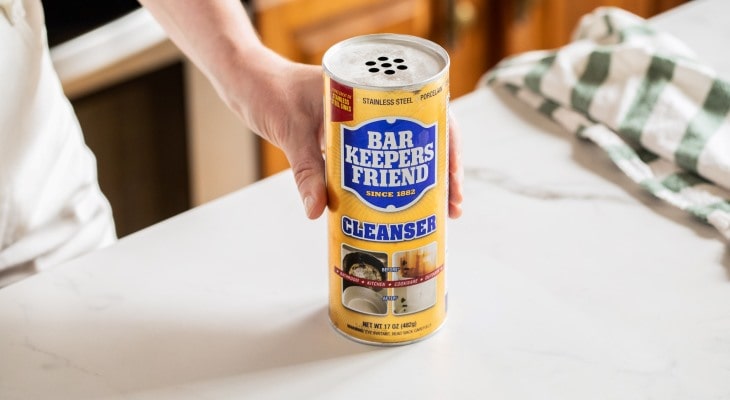Bar Keepers Friend (or BKF) is a well-loved cleanser that’s almost 140 years old. It’s coveted by many for its multipurpose abilities and fairly straightforward use.
Still, there are many questions about the safest and most effective way to use it.
Because Bar Keepers Friend has so many applications and potential uses, there’s a lot of confusion about how to get it to work best, such as what to mix it with, what to use it on, and what kind of damage might occur if it’s used improperly.
Table of Contents
What is Bar Keepers Friend?

As I mentioned, this cleaner is a very old formula. It was originally designed to clean stainless steel in bars.
Its main ingredient is oxalic acid, and it is considered an abrasive cleaner. It originally only came in powdered form but now it’s available in liquid and foam formulations as well.
Implications with Mixing

It’s not unusual for people to want to mix cleaners together in an effort to expand their abilities. So what can Bar Keepers Friend be mixed with safely?
Bar Keepers Friend and Bleach
This cannot be stressed enough – the only thing you should ever mix with bleach is water. Bleach is such a strong and powerful chemical that its safe use can never be overstated.
Mixing Bar Keepers Friend with bleach creates a chemical reaction that produces chlorine gas fumes which are toxic if inhaled and can be deadly.
Bar Keeper’s Friend and Vinegar
BKF already has oxalic acid as its main ingredient, which is fairly powerful. Vinegar is itself a fairly weak acid, and mixing the two cleaners together won’t do much.
Bar Keepers Friend is more powerful than vinegar in every sense, so you will essentially be wasting your time, and you see the benefits you hope to see.
Bar Keepers Friend vs. Baking Soda
The key difference between these two cleaners is that baking soda is considered a base, and BKF is an acid.
Baking soda won’t be able to remove some rust and other tough stains as well as BKF can, but baking soda would be a better choice for more sensitive materials.
When it comes to mixing the two cleaners, it will produce the same result as mixing Bar Keepers Friend with vinegar – which is essentially nothing. While it’s not particularly harmful, it’s also not beneficial enough to be worth the effort to mix them.
Proper Use
Every cleaning agent has fairly straightforward instructions on how to use it correctly, and BKF is no different.
Always Mix It With Water
The general use of Bar Keeper’s Friend includes creating a slurry by mixing the powder with water and applying it over the area to be cleaned. Then you let it sit for a short amount of time, scrub, and rinse the area clean.
Not mixing it with water and attempting to dry scrub an area can result in a too abrasive clean, and it won’t have the lifting power it needs. The ingredients need water to be activated properly.
Don’t Let it Sit Too Long
There is a sweet spot in regards to timing when it comes to letting Bar Keepers Friend sit before scrubbing. It gives the formula time to work into the problem area and lift up any stains or gunk you are trying to remove.
The usual recommended time is 10-15 minutes. If Bar Keepers Friend is left on too long, it has the potential to cause discoloration that looks similar to bleach stains. Remember – this is a very powerful cleaner. Once the color has been pulled from a surface, it’s basically impossible to fix it.
Be Careful on Modern Stainless Steel
While Bar Keepers Friend was originally marketed to shine up stainless steel, most modern-day appliances have a lacquered coating on the outside that can be scrubbed off if you use a cleaner that is too powerful.
If you must use it for this purpose, it’s recommended that you skip the time you usually would allow it to sit for. Apply the slurry and gently scrub right away. Afterwards, make sure you rinse it thoroughly.
Bar Keepers Friend can safely clean sterling silver as well using the same principles.
Don’t Use It on Everything
While non-porous surfaces can generally be cleaned very well with Bar Keepers Friend, there are certain materials that you should never try to use it on. Its powerful ingredients can permanently damage them. The list of such materials include:
- Granite
- Cast Iron
- Leather
- Marble
- Wood
- Fabric
- Any painted surface
- Real silver (sterling silver is okay)
- Gold
It Can be Used on Glass
Bar Keepers Friend is very efficient at removing build-up soap scum and other stains on glass. You should wet the area first and then apply the slurry. As for the sitting time, one minute is sufficient for it to cut through most nasty stuff.
Afterwards, simply rinse and watch it shine!
Other Formulations and Uses

Even though its original use and the powdered formula was for polishing stainless steel, the expanded line of products from BKF allows you to get the same cleaning power on different surfaces.
The foaming formula and their Soft-Cleanser line are premixed so they can be applied directly to surfaces that may be too sensitive to original powder abrasives. There are also cooktop and cookware cleaning products whose ingredients are more food safe.
Aside from kitchen and food service use, it is able to be used on floors such as tile and grout, as well as your fixtures – the faucets, sinks, and toilets. Use it on your car rims as well to really clean them up.
Final Thoughts
By now, I think you can appreciate just how versatile this cleaner is and why it’s beloved by many. It is something to consider making a part of your cleaning arsenal, and you will find yourself reaching for it quite often.
But just like with any cleaner, its effectiveness is limited if it’s not used correctly. So be sure to check the label and research the surface you wish to use it on if you are in doubt.


I accidentally left the bar keeper friend solution overnight and now my sink is stained. Does anyone have any solutions?
(Mixing BKF with baking soda) “will produce the same result as mixing Bar Keepers Friend with vinegar – which is essentially nothing.” – This is incorrect. It will have an opposite effect. As you said yourself, baking soda is an alkaline (base) and BKF is an acid. When acid and alkaline mix they neutralize each other and produce water and salts.
If you mix an acid with something else, the resulting PH will generally be the average of the two. Water is neutral. Some is needed to transport the acid, and more than that just dilutes the strength of the acid.
Vinegar is a weak acid. It will work the same way as water and the resulting blend will be slightly more acidic than the water blend. But probably not enough to make a noticeable improvement in cleaning power.
Baking powder is an alkaline. Adding it to a mix of BKF & water will weaken the acid and reduce its cleaning power. Whether the difference is noticeable will depend on how much you add. But regardless, it will reduce the cleaning power, not improve it. (Same reason it’s counterproductive to add vinegar to dishwasher detergent, laundry detergent, etc.)